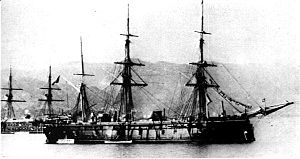Roma-class ironclad

Roma at anchor in September 1870
|
|
| Class overview | |
|---|---|
| Name: | Roma class |
| Builders: | Cantiere della Foce |
| Operators: |
|
| Preceded by: | Regina Maria Pia class |
| Succeeded by: | Affondatore |
| Built: | 1863–1873 |
| In commission: | 1869–1895 |
| Completed: | 2 |
| Retired: | 2 |
| General characteristics | |
| Type: | Ironclad warship |
| Displacement: |
|
| Length: | 79.67 m (261 ft 5 in) |
| Beam: | 17.33 m (56 ft 10 in) |
| Draft: | 7.57 m (24 ft 10 in) |
| Installed power: |
|
| Propulsion: | One single-expansion steam engines |
| Speed: | 13 knots (24 km/h; 15 mph) |
| Range: | 1,940 nmi (3,590 km) at 10 kn (19 km/h; 12 mph) |
| Complement: | 549–551 |
| Armament: |
|
| Armor: | Belt armor: 5.9 in (150 mm) |
The Roma class was a pair of ironclad warships built for the Italian Regia Marina (Royal Navy) in the 1860s and 1870s. The class comprised two ships, Roma and Venezia. Roma was a broadside ironclad armed with five 10-inch (254 mm) and twelve 8-inch (200 mm) guns, while Venezia was converted into a central battery ship during construction, armed with a much more powerful battery of eighteen 10-inch guns. Neither ship had an eventful career, due in large part to their rapid shift to obsolescence. Venezia and Roma were withdrawn from service for auxiliary duties in 1880 and 1890, respectively. Both were stricken from the naval register in 1895 and broken up for scrap the following year, Roma having been badly damaged in a fire in 1895.
The Roma class was designed by Insp. Eng. Giuseppe De Luca, who initially planned to build both ships as broadside ironclads. By this time, however, other navies had begun to build central battery ships, which concentrated a smaller number of guns in an armored casemate that had limited capability for end-on fire. This change allowed the ship to be shorter, which in turn required less armor and made the ship more maneuverable. As a result, De Luca re-designed the second ship of the class, Venezia, into a central battery ironclad while she was under construction.
The ships of the Roma class had wooden hulls, though they did incorporate some iron in their construction. The two ships varied slightly in their dimensions, a result of Venezia having been converted into a central battery ship during construction. Roma was 79.67 meters (261.4 ft) long between perpendiculars; she had a beam of 17.33 m (56.9 ft) and an average draft of 7.57 m (24.8 ft). Venezia was 79.65 m (261.3 ft) between perpendiculars, with a beam of 17.48 m (57.3 ft) and a draft of 7.6 m (25 ft). Roma displaced 5,698 metric tons (5,608 long tons; 6,281 short tons) normally, while Venezia displaced 5,722 t (5,632 long tons; 6,307 short tons). Both ships displaced 6,151 t (6,054 long tons; 6,780 short tons) at full load. The ships had a crew of 549–551 officers and men.
...
Wikipedia
